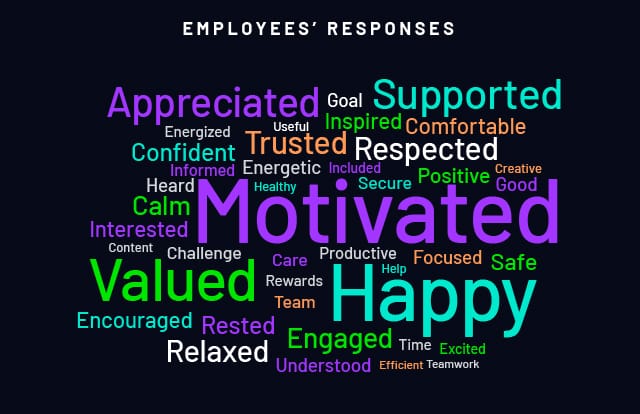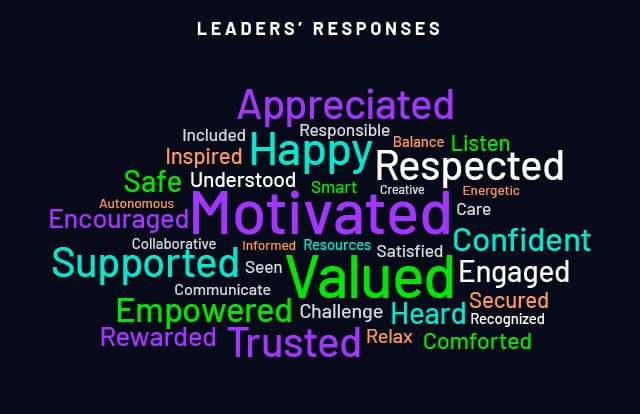Written by Jill Pennington, VP, International Consulting
In 2021, Talogy conducted research that identified the need for organisations to rethink leadership – both the role that leaders play and the attributes that will be needed to lead organisations into the future. Our findings highlighted the need for a shift towards more connected, people focused, and agile leadership as well as leaders who understand that employees’ feelings really do impact employee engagement, company culture, and the way organisations perform.
The way employees feel impacts performance
In that 2021 leadership research, the top six emotions identified by employees and leaders when asked how employees need to feel to perform at their best were motivated, happy, appreciated, supported, trusted, and valued (See Figure 1 below). Whilst it seems obvious that people perform better when they feel better, the significance of this can sometimes be overlooked as leaders’ prime focus can be on getting the job done. And yet, by paying a bit more attention to employees’ feelings, leaders could get the job done better and quicker.
There are two key reasons for this. Firstly, leadership has a major impact on how people feel at work, and therefore how they behave and perform. Secondly, the type of challenges that leaders grapple with daily are too complex for them to solve alone. They need employees to contribute fully, work collaboratively, and be flexible. To do this, employees need to feel positive emotions such as motivation, happiness, and value.
Figure 1: How do employees need to feel to perform at their best?


In 2018, we conducted research into leadership climate which demonstrated a statistical link between the climate created by leaders (how it feels to be led by them) and three important aspects of employee experience – engagement, psychological safety, and agility. These three things are higher when leaders are more inclusive and inspiring compared to leaders who demonstrate controlling and withdrawing behaviours.
A 2019 study carried out by BT in the UK and the University of Oxford looked at whether happiness improved productivity in call centre staff. Results showed that productivity increased when employees were happier. This was not because they worked longer hours but because employees worked in different ways when they felt happy. The study found that when people were happier at work, they:
- Were better at organising their time and achieved their work schedules more easily
- Could work faster and answer a higher number of calls per hour
- Were more efficient at converting calls into sales
Employees are placing more importance on well-being and how they feel at work
Whilst research shows a link between feelings of job satisfaction and performance, employees are prioritising how they feel at work and about work more today than in the past. Employee expectations of work are changing. They want to have more meaning in their work. They want to work for ethical and socially responsible employers, and they want more flexibility around when and where they work. Employees want to feel motivated, valued, and supported and are increasingly looking for work that enables this.
However, employee engagement doesn’t seem to be improving
Despite our need to feel better at and about work, according to Gallup, 60% of people are emotionally detached at work and 19% are miserable. With global employee engagement stagnating at around 21% (Gallup 2022), there is a huge opportunity for organisations to improve performance by focusing on how employees feel about work and at work.
With nearly a fifth of employees unhappy at work and over half feeling detached, employee disengagement and apathy is the exact opposite of what is needed by employers facing challenges that require innovation, agility, and collaboration. Increased hybrid working and automation of people processes are exacerbating this by reducing how often leaders and employees connect either in person or virtually. So, what can be done?
7 realistic steps to prioritise the employee experience
These statistics make it clear that we need to rethink leadership and the relationship between leaders and the employee experience. If feeling happy increases productivity – especially without people needing to work longer – then prioritising how to support, value, trust, and appreciate employees better is a no brainer. Here are seven things leaders can do:
- Pay attention to how employees feel and what they think – Feelings really do impact the employee life cycle and performance, and yet when was the last time your boss asked you how you are feeling? When new ideas are tabled for discussion, how much time is spent on how it will impact employees’ feelings? Leaders can be reluctant to ask about feelings in case the response raises issues that are hard to address. However, not asking has a more negative impact than asking, and leaders need to lose the idea that they must have all the answers. In an ever more complex working environment, employees don’t expect problems to be addressed immediately, but they do expect to be asked about how they feel and what they think.
- Set a clear ethos and purpose for the work that people do – Talk about how you want customers to feel about your products and services. Make sure there is a shared view of what good personal and professional performance looks like. Balance talking about financial targets with talking about the reason why your organisation or team exists. Give people a compelling reason to come to work.
- Give the right amount of power – Lose the feeling that you need to have the answers and make the decisions. Organise work so it is done at the right level. Change where decisions are made so people who have the most insight are involved and not just impacted. Give the people who serve customers the authority and agility they need.
- Connect with employees then lead – Get to know your team. Understand what motivates them. Let them get to know you. Build strong connections within the team to enable cooperation and collaboration. Don’t let automated processes like performance reviews reduce the depth of conversations with your team. Make sure everyone is given the opportunity to contribute and prioritise inclusion – don’t just listen to the loudest voices in the room.
- Keep people on their toes – Challenge the team to look outwards and keep up to date with what is happening inside and outside your organisation. Use innovative thinking methods to solve problems and encourage diverse thinking to increase employee engagement.
- Be consistent – Approach setbacks or mistakes with a balanced outlook. Take care to manage how you express your emotions when things go wrong, or mistakes are made. Look to maintain psychological safety so that issues can be discussed honestly and openly.
- Set the bar high but achievable – People love to be stretched and to learn. Provide clear expectations and hold people accountable. Balance this with support and a clear sense of purpose.
Ways leaders can drive results in challenging environments
Leaders are under significant pressure to adapt, deliver results, and drive efficiency in challenging operating environments. Busyness and pressure can mean leaders neglect the ‘people side’ of leadership and become less aware of how much feelings matter. I challenge leaders to do these three things:
- Stop thinking about tasks and people in separate ‘buckets.’
- Reflect on how you think about tasks and people and pay equal attention to how your team feels and the job to be done.
- Listen to, understand, and involve employees and you will see performance, productivity, and agility improve.
Want to understand more? Read our blog on 6 ways to demonstrate people-centred leadership and how to set leaders up for success.


